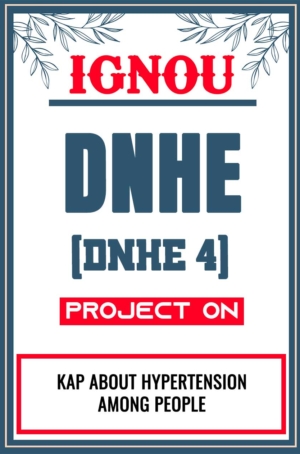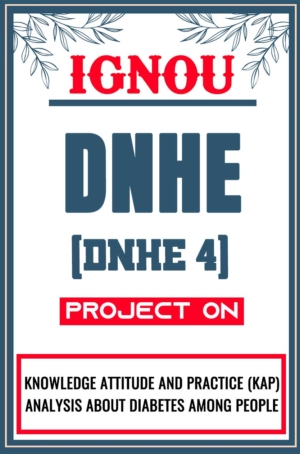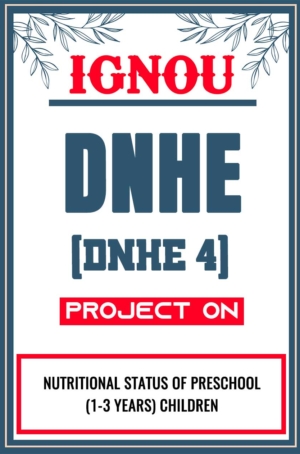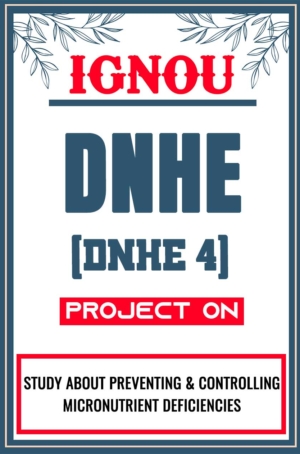IGNOU DNHE-4 Project – Order Personalized or Ready-Made Nutrition & Health Education Report & Synopsis with Topics, Formatting as per Guidelines
Full form of DNHE is Diploma in Nutrition and Health Education. It’s a Diploma Program provided by IGNOU for the leaner to develop skills in communicating health and nutrition related information to the people of various places. IGNOU DNHE Project is a very important part of the DNHE program. This project will help the student to plan and carry out nutrition/ health education campaigns and program in community.
The course IGNOU DNHE Project offers students an engaging introduction to the essential topics related to health and nutrition. IGNOU DNHE Project is a research assignment, given to student which requires a larger amount of effort; it requires students to undertake their own fact finding for IGNOU DNHE 4 Synopsis and IGNOU DNHE 4 Report.
Whatsapp us to get the Personalized (Customized) IGNOU DNHE Project Report and Synopsis
Download Link for IGNOU DNHE Project (DNHE-4 PDF)
What are the common methodologies used in IGNOU DNHE Projects?
In the DNHE project for the Diploma in Nutrition and Health Education, various methodologies can be employed based on the nature and objectives of the project. Here are some common methodologies used:
1. Surveys and Questionnaires:
- Purpose: Collect quantitative data from a large sample on specific nutrition and health-related topics.
- Application: Useful for gathering information on dietary habits, health practices, or community needs.
- Process: Design a structured questionnaire, distribute it to the target population, and analyze the responses statistically.
2. Interviews:
- Purpose: Gain in-depth qualitative insights from individuals or groups.
- Application: Effective for exploring personal experiences, perceptions, and detailed opinions on nutrition and health issues.
- Process: Conduct structured or semi-structured interviews, record and transcribe responses, and analyze themes or patterns.
3. Focus Groups:
- Purpose: Facilitate discussions with groups to explore attitudes, beliefs, and opinions.
- Application: Useful for understanding community needs, preferences, or responses to health education interventions.
- Process: Organize and moderate group discussions, record and transcribe conversations, and analyze group dynamics and feedback.
4. Case Studies:
- Purpose: Examine specific instances or cases in detail to understand complex issues.
- Application: Ideal for investigating particular nutrition and health interventions or programs.
- Process: Select and document case studies, collect data through various sources, and provide a comprehensive analysis of the case.
5. Experimental or Intervention Studies:
- Purpose: Evaluate the effectiveness of nutrition or health interventions.
- Application: Useful for testing new dietary programs, health education strategies, or community-based initiatives.
- Process: Design an intervention, implement it in a controlled setting, and measure outcomes to assess impact.
6. Observational Studies:
- Purpose: Observe and record behaviors or conditions without intervention.
- Application: Effective for studying dietary practices, health behaviors, or environmental factors.
- Process: Develop an observation plan, record data systematically, and analyze observations for trends and patterns.
7. Content Analysis:
- Purpose: Analyze textual or visual content to understand themes or trends.
- Application: Useful for evaluating educational materials, media campaigns, or public health communications.
- Process: Collect and categorize content, identify themes or patterns, and interpret findings in relation to your project objectives.
8. Program Evaluation:
- Purpose: Assess the effectiveness and efficiency of existing nutrition and health programs.
- Application: Ideal for evaluating community health programs, school-based initiatives, or public health interventions.
- Process: Define evaluation criteria, collect data on program performance, and analyze results to provide recommendations for improvement.
9. Literature Review:
- Purpose: Synthesize existing research and information on a particular topic.
- Application: Useful for understanding the current state of knowledge on a nutrition or health issue and identifying gaps.
- Process: Review and summarize relevant literature, identify key findings and trends, and discuss their implications for your project.
10. Participatory Action Research (PAR):
- Purpose: Engage community members in the research process to address local issues collaboratively.
- Application: Effective for community-based projects where local input and participation are crucial.
- Process: Collaborate with community members to identify issues, design and implement interventions, and evaluate outcomes together.
How do you ensure the quality of your DNHE project?
Follow a systematic approach in planning and executing your project. Adhere to the approved methodology, collect and analyze data accurately, and ensure your report is clear and comprehensive.
IGNOU DNHE Project Topics for DNHE-4
- A Study On Management Of Diabetes Mellitus In Xyz City
- A Study On Knowledge, Attitude And Practices (Kap) Analysis Of Pregnant Women Towards Their Nutritional Status
- Obesity Prevalance Among School Children In The Age Group Of 13-17 Years
- Nutritional Status Of Children & Knowledge, Attitude And Practices Among Parents Regarding Dengue Infection In School Children
- Nutritional Awareness And Preferences For Ready To Eat Foods Amongst Working And Non-Working Women In Xyz City
- Knowledge, Attitude And Practice (Kap) Analysis Of Mothers Regarding Nutritional Status And Diet Intake Of Their Children Of Age Group 2 To 5 Years
What should the final IGNOU DNHE Project report include?
The final project report for the DNHE project should be comprehensive, well-organized, and cover all essential aspects of your project. Here is a detailed outline of what the final project report should include:
1. Title Page:
- Project Title
- Your Name and Enrollment Number
- Course Code and Title (DNHE-4: Project Work)
- Name of the Supervisor
- Date of Submission
2. Acknowledgements:
- Acknowledge the support and assistance of individuals and institutions that helped you complete the project.
3. Table of Contents:
- List of chapters, sections, and page numbers for easy navigation.
4. Abstract:
- A brief summary of the project, including the objectives, methodology, key findings, and conclusions. This should be concise (150-250 words).
5. Introduction:
- Background: Provide context and background information on the topic.
- Problem Statement: Clearly state the problem or issue your project addresses.
- Objectives: Outline the main objectives of your project.
- Significance: Explain the significance and relevance of the project.
6. Literature Review:
- Review existing literature related to your project topic.
- Identify gaps in the current knowledge and how your project addresses them.
- Summarize key findings from previous research.
7. Methodology:
- Research Design: Describe the overall research design and approach.
- Data Collection Methods: Detail the methods used for data collection (e.g., surveys, interviews, observations).
- Sampling: Explain the sampling techniques and the sample size.
- Data Analysis: Describe the tools and techniques used for data analysis.
- Ethical Considerations: Discuss any ethical issues and how they were addressed.
8. Results:
- Present the findings of your project clearly and systematically.
- Use tables, charts, and graphs to illustrate the data.
- Provide a detailed analysis of the results.
9. Discussion:
- Interpret the results in the context of your objectives.
- Compare your findings with existing literature and research.
- Discuss any unexpected results and possible explanations.
- Address the limitations of your study.
10. Conclusion:
- Summarize the key findings and their implications.
- Highlight the main conclusions drawn from the project.
- Provide recommendations based on your findings.
11. Recommendations:
- Suggest practical applications of your findings.
- Propose areas for future research or further investigation.
12. References:
- List all the sources cited in your report.
- Follow a consistent citation style (e.g., APA, MLA, Chicago).
13. Appendices:
- Include any supplementary material such as questionnaires, interview guides, raw data, or additional charts.
- Label each appendix clearly and refer to them in the main text as needed.
How do you prepare for the IGNOU DNHE Project presentation?
Preparing for the project presentation of your IGNOU DNHE-4 project involves several steps to ensure that you effectively communicate your research findings and insights. Here is a comprehensive guide to help you prepare:
1. Understand the Requirements:
- Presentation Duration: Know the time allotted for your presentation and plan accordingly.
- Format: Confirm the format (e.g., PowerPoint slides, oral presentation) and any specific guidelines provided by your institution or supervisor.
- Audience: Understand who will be in your audience (e.g., faculty, peers) and tailor your presentation to their level of knowledge and interest.
2. Structure Your Presentation:
Introduction:
- Briefly introduce yourself and your project topic.
- State the purpose and objectives of your project.
- Provide a brief overview of the structure of your presentation.
Literature Review:
- Summarize key findings from the literature review that are relevant to your project.
- Highlight any gaps or areas that your project addresses.
Methodology:
- Explain the research design and methods used for data collection and analysis.
- Justify why these methods were chosen and how they were implemented.
Results:
- Present the main findings of your project.
- Use visual aids such as charts, graphs, and tables to illustrate the data.
- Explain the significance of the results.
Discussion:
- Interpret the results in the context of your research objectives.
- Compare your findings with existing literature.
- Discuss any unexpected findings and their implications.
Conclusion:
- Summarize the key points of your presentation.
- Highlight the main conclusions and recommendations.
- Suggest areas for future research.
Q&A Session:
- Prepare for potential questions from the audience.
- Think about possible queries related to your methodology, findings, and conclusions.
3. Create Effective Visual Aids:
PowerPoint Slides:
- Keep slides clear and uncluttered.
- Use bullet points to highlight key information.
- Incorporate visual aids (graphs, charts, images) to support your points.
- Use a consistent font and color scheme.
Handouts:
- Prepare handouts if required or helpful for your audience.
- Include key information, charts, or summaries that complement your presentation.
4. Practice Your Presentation:
Rehearse:
- Practice delivering your presentation multiple times.
- Time yourself to ensure you stay within the allotted time.
- Focus on clarity, pacing, and articulation.
Seek Feedback:
- Practice in front of peers, friends, or family members and ask for feedback.
- Use their feedback to make improvements.
5. Prepare for the Q&A Session:
Anticipate Questions:
- Think about potential questions related to your research and prepare responses.
- Be ready to explain and justify your methodology, findings, and conclusions.
Stay Calm:
- Listen carefully to each question.
- Take a moment to think before responding.
- Be honest if you don’t know the answer and offer to follow up if necessary.
6. Final Preparations:
Technical Check:
- Ensure all technical equipment (laptop, projector, pointer) is working properly.
- Have a backup plan in case of technical issues (e.g., printed slides, USB drive).
Dress Appropriately:
- Dress professionally to make a positive impression.
Bring Necessary Materials:
- Bring a copy of your report, notes, and any other materials you might need.
7. On the Day of the Presentation:
Arrive Early:
- Arrive at the venue early to set up and test the equipment.
- Ensure everything is in place and working correctly.
Stay Confident:
- Take deep breaths to calm your nerves.
- Remember that you are the expert on your project.
Can you include appendices in your IGNOU DNHE Project report?
Yes, you can include appendices in your project report. Appendices are useful for providing supplementary material that supports the main text of your report but would be too lengthy or detailed to include in the main body. Here are some guidelines and examples of what you might include in the appendices:
Purpose of Appendices:
- Supplementary Information: Provide additional data, detailed explanations, or supplementary documents that support your research.
- Clarity: Include materials that help clarify the main text without interrupting the flow of your report.
- Evidence: Provide raw data, detailed calculations, or other evidence that supports your findings.
Types of Materials to Include in Appendices:
- Survey Instruments: Copies of questionnaires or surveys used in your research.
- Interview Transcripts: Full transcripts of interviews conducted as part of your study.
- Raw Data: Detailed data tables, raw data sets, or extensive statistical outputs.
- Additional Charts and Graphs: Visual aids that are referenced in the main text but too detailed to include there.
- Supplementary Analysis: Additional analyses or detailed calculations that support your main findings.
- Ethical Approvals: Copies of consent forms, ethical approval letters, or any other documentation related to ethical considerations.
- Additional Literature: Extended reviews of literature or additional references that support your research.
- Photographs or Illustrations: Images, photographs, or diagrams that provide further context or evidence.
Formatting Appendices:
- Labeling: Clearly label each appendix with a letter or number (e.g., Appendix A, Appendix B, etc.).
- Title: Provide a title for each appendix that describes its content (e.g., “Appendix A: Survey Questionnaire”).
- Referencing in Text: Refer to the appendices in the main text of your report where relevant (e.g., “See Appendix A for the survey questionnaire”).
- Order: Arrange appendices in the order they are referenced in the main text.
Ready to get your IGNOU DNHE Project Report and Synopsis Sample PDF for DNHE-4?
- Call us or WhatsApp us at: 9958947060, 9354637830
- Visit: SHRICHAKRADHAR.COM.
-
Sale!

-
Sale!

IGNOU DNHE Project (DNHE 4) Synopsis/Proposal & Project Report/Dissertation in Hard-Copy (Sample-7)
Original price was: ₹499.00.₹249.00Current price is: ₹249.00. -
Sale!

IGNOU DNHE Project (DNHE 4) Synopsis/Proposal & Project Report/Dissertation in Hard-Copy (Sample-6)
Original price was: ₹499.00.₹249.00Current price is: ₹249.00. -
Sale!

IGNOU DNHE Project (DNHE 4) Synopsis/Proposal & Project Report/Dissertation in Hard-Copy (Sample-5)
Original price was: ₹499.00.₹249.00Current price is: ₹249.00. -
Sale!

IGNOU DNHE Project (DNHE 4) Synopsis/Proposal & Project Report/Dissertation in Hard-Copy (Sample-4)
Original price was: ₹499.00.₹249.00Current price is: ₹249.00. -
Sale!

IGNOU DNHE Project (DNHE 4) Synopsis/Proposal & Project Report/Dissertation in Hard-Copy (Sample-3)
Original price was: ₹499.00.₹249.00Current price is: ₹249.00. -
Sale!

IGNOU DNHE Project (DNHE 4) Synopsis/Proposal & Project Report/Dissertation in Hard-Copy (Sample-2)
Original price was: ₹499.00.₹249.00Current price is: ₹249.00. -
Sale!

IGNOU DNHE Project (DNHE 4) Synopsis/Proposal & Project Report/Dissertation in Hard-Copy (Sample-1)
Original price was: ₹499.00.₹249.00Current price is: ₹249.00.
